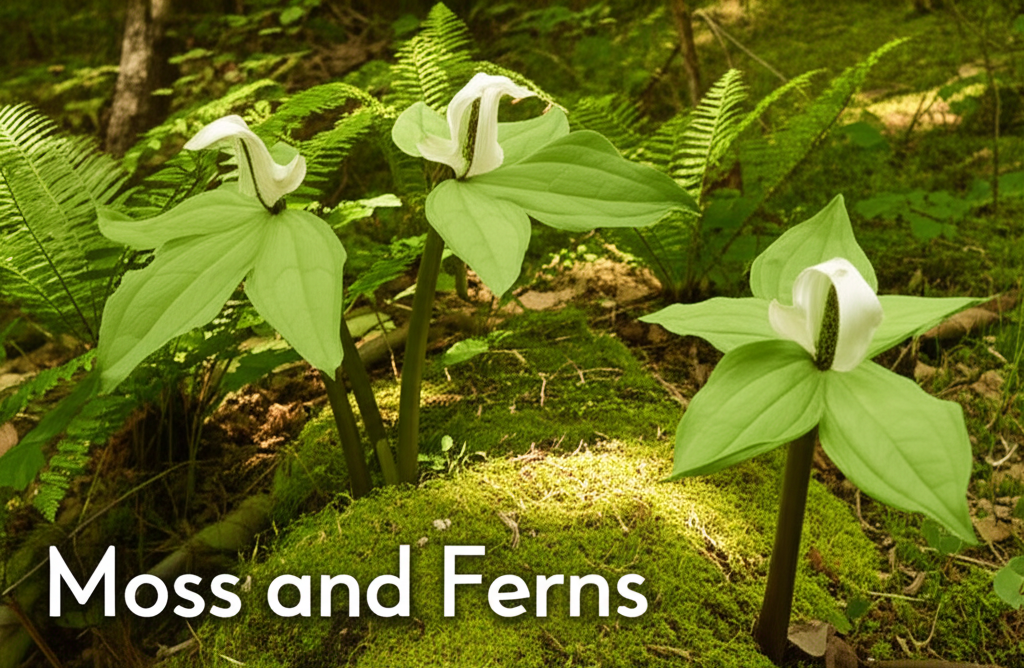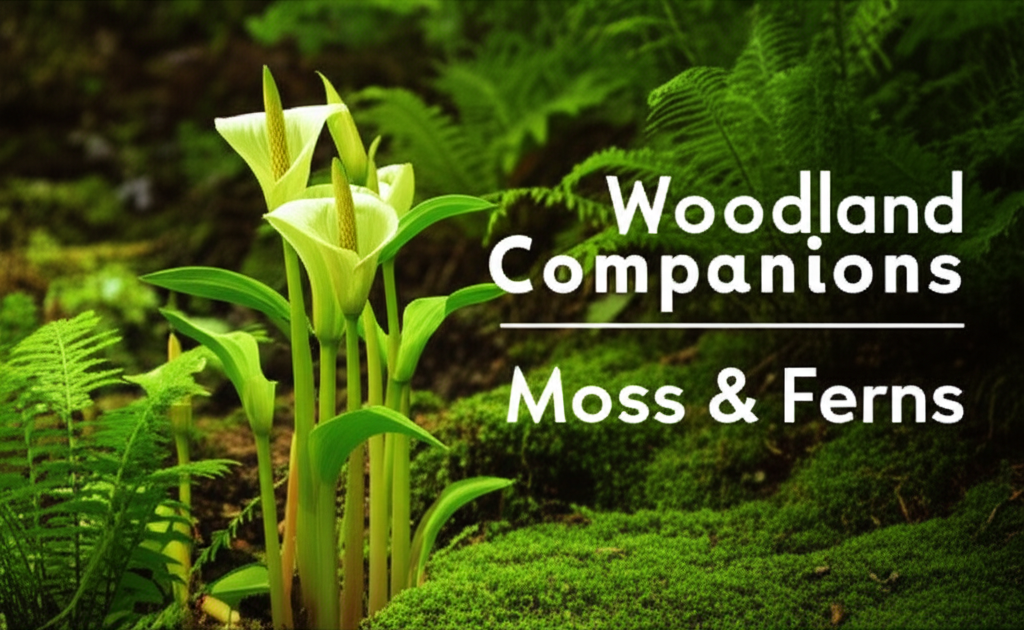Introduction: The Allure of the Woodland Garden
The dappled sunlight filtering through a dense forest canopy creates a unique microclimate, a sanctuary for plants that thrive in shade and moisture. Within this enchanting understory, the Jack-in-the-Pulpit (Arisaema triphyllum) stands as a botanical marvel, its distinctive spathe and spadix resembling a preacher at a lectern. To truly capture the essence of this woodland gem and foster a thriving ecosystem, understanding its companion planting needs is paramount. This article delves into the synergistic relationship between Jack-in-the-Pulpit and its most natural and beneficial companions: mosses and ferns. By creating a cohesive planting scheme, we can replicate the beauty and ecological balance of the forest floor, encouraging robust growth and a visually stunning garden.
Understanding Jack-in-the-Pulpit: A Unique Woodland Native

Before we explore its companions, it’s essential to understand the Jack-in-the-Pulpit itself. This perennial wildflower is native to eastern North America and is characterized by its striking flower, which is actually a modified leaf structure. The spathe, often green with purple veins, enfolds the spadix, the true flower cluster. It prefers moist, well-drained, humus-rich soil and thrives in partial to full shade. Its dormant period in summer, where it often disappears, is a crucial aspect of its life cycle that influences companion planting choices. Understanding its need for consistent moisture without waterlogging and its preference for acidic to neutral soil pH is key to successful cultivation.
Key Characteristics of Jack-in-the-Pulpit:
- Native Range: Eastern North America
- Light Requirements: Partial to full shade
- Soil Preferences: Moist, well-drained, humus-rich, acidic to neutral pH
- Bloom Time: Late spring to early summer
- Dormancy: Summer
- Distinctive Feature: Spathe and spadix inflorescence
The Symbiotic Appeal: Why Moss and Ferns are Ideal Companions
Mosses and ferns are not merely aesthetically pleasing additions to a Jack-in-the-Pulpit planting; they are ecological partners that enhance the plant’s growth and survival. Their shared habitat requirements and growth habits create a beneficial synergy.
Moss: The Groundcover Maestro
Mosses are ancient, non-vascular plants that form lush carpets on forest floors. They excel at retaining moisture, preventing soil erosion, and creating a cool, stable microclimate. For Jack-in-the-Pulpit, this translates to:
- Moisture Retention: Moss acts like a natural sponge, keeping the soil around the Jack-in-the-Pulpit consistently moist without becoming waterlogged, which is crucial during its active growing season and can prevent the corm from drying out during its dormancy.
- Temperature Regulation: The dense growth of moss helps to insulate the soil, keeping it cooler in summer and warmer in winter, protecting the delicate roots and corm of the Jack-in-the-Pulpit from extreme temperature fluctuations.
- Erosion Control: Their intricate root systems bind the soil, preventing it from being washed away by rain, which is particularly important on slopes or in areas with heavy rainfall.
- Nutrient Cycling: As moss decomposes, it contributes organic matter to the soil, enriching it with essential nutrients over time.
- Aesthetic Harmony: The soft, verdant textures of moss create a naturalistic backdrop that perfectly complements the architectural form of the Jack-in-the-Pulpit.
Ferns: The Structural Pillars of the Understory
Ferns are vascular plants that have evolved to thrive in shady, moist environments. Their varied forms, from delicate fronds to robust structures, provide visual interest and functional benefits to a Jack-in-the-Pulpit garden.
- Shade Provision: Taller fern species can offer additional shade, further protecting the Jack-in-the-Pulpit from harsh sun, especially in the afternoon.
- Soil Aeration: The root systems of many ferns help to improve soil structure, promoting better aeration which is beneficial for the Jack-in-the-Pulpit’s rhizomatous growth.
- Moisture Competition Management: While ferns do require moisture, their water uptake is generally manageable when planted with Jack-in-the-Pulpit, and they don’t typically compete aggressively for resources in a well-balanced setting.
- Pest Deterrence (Potential): Some ferns may naturally deter certain garden pests, although this is a less pronounced benefit compared to their structural and aesthetic contributions.
- Seasonal Interest: Ferns offer a long season of interest, from their unfurling fiddleheads in spring to their enduring fronds throughout the summer and even into fall, providing a consistent green presence.
Key Facts and Comparison: Jack-in-the-Pulpit, Moss, and Ferns
To further illustrate the compatibility, let’s compare the fundamental needs and characteristics of these three woodland dwellers.
| Feature | Jack-in-the-Pulpit | Moss | Ferns |
|---|---|---|---|
| Light Requirement | Partial to full shade | Shade to partial shade | Shade to partial shade |
| Moisture Need | Consistently moist, well-drained | High, prefers constant moisture | Consistently moist, well-drained |
| Soil pH | Acidic to neutral (6.0-7.0) | Slightly acidic to neutral | Slightly acidic to neutral |
| Soil Type | Humus-rich, loamy | Moist, organic-rich | Humus-rich, loamy, well-drained |
| Growth Habit | Perennial herb, corm-based, summer dormancy | Low-growing, spreading groundcover | Varies; herbaceous perennials with rhizomes/runners |
| Benefit to Companions | Provides structural interest | Retains moisture, regulates temperature, prevents erosion | Provides shade, improves soil structure, adds visual depth |
| Compatibility Level | Excellent | Excellent | Excellent |
Selecting the Right Moss and Fern Varieties
While many mosses and ferns will naturally find common ground with Jack-in-the-Pulpit, choosing species that are well-suited to your specific region and microclimate will yield the best results.
Recommended Mosses for Woodland Gardens:
- Sheet Moss (Hypnum muscillagineum): Forms extensive, flat mats and is quite resilient.
- Cushion Moss (Leucobryum glaucum): Creates attractive, dense mounds.
- Sphagnum Moss (Sphagnum spp.): Excellent for moisture retention and can tolerate slightly acidic conditions. Be mindful of harvesting sustainably if collecting from the wild.
Recommended Ferns for Woodland Gardens:
- Ostrich Fern (Matteuccia struthiopteris): Known for its tall, elegant fronds that emerge in a vase-like shape. It spreads via rhizomes and appreciates moist soil.
- Maidenhair Fern (Adiantum pedatum): Delicate, airy fronds on black stems create a lace-like effect. It requires consistent moisture and good air circulation.
- Lady Fern (Athyrium filix-femina): A common and adaptable fern with finely divided, lacy fronds. It tolerates a range of shade conditions and soil moisture.
- Christmas Fern (Polystichum acrostichoides): An evergreen fern that provides winter interest, retaining its fronds through the colder months. It is more drought-tolerant than some other ferns but still prefers consistent moisture.
- Cinnamon Fern (Osmunda cinnamomea): Tall, striking fronds with a distinctive cinnamon-colored spore-bearing frond in the center. It thrives in moist to wet soil.
Designing Your Jack-in-the-Pulpit Haven: Planting Strategies
The success of companion planting lies in thoughtful design and execution. Here’s how to create a harmonious and thriving understory garden.
Site Preparation is Key:
- Soil Amendment: Before planting, enrich your soil with generous amounts of compost or well-rotted leaf mold. This will improve drainage, increase water retention, and provide essential nutrients. Aim for a soil pH between 6.0 and 7.0.
- Clearing the Area: Remove any competing weeds or invasive plants that could siphon resources from your desired flora.
- Moisture Assessment: Ensure the site naturally retains moisture or that you can reliably provide it. Areas that dry out quickly will not be suitable.
Planting Techniques for Synergy:
- Layering for Effect: Place taller ferns towards the back or sides of the planting area, with Jack-in-the-Pulpit in the mid-ground. Mosses should be used as a groundcover, filling in the spaces between plants and around their bases.
- Spacing for Growth: Allow adequate space for each plant to reach its mature size. Overcrowding can lead to competition for light, water, and nutrients. Refer to individual plant spacing recommendations.
- Mimicking Nature: Observe natural woodland settings for inspiration on how these plants grow together. Irregular clusters and natural drifts often look more appealing than rigid rows.
- Consider Dormancy: Since Jack-in-the-Pulpit disappears in summer, interplanting with ferns that maintain their foliage or other shade-loving perennials with later bloom times can ensure continuous visual interest.
Ongoing Care and Maintenance for a Thriving Understory
Once established, this woodland ensemble requires minimal, yet consistent care.
Watering:
- Deep and Infrequent: Water deeply when the top inch of soil begins to feel dry, rather than shallow, frequent sprinklings. This encourages deeper root growth.
- Monitor Moisture Levels: Especially during dry spells, check the moisture levels of the soil. Moss should remain slightly damp, and the soil around the Jack-in-the-Pulpit should not be allowed to dry out completely.
Mulching:
- Organic Mulch: A layer of organic mulch, such as shredded leaves or pine needles, helps retain soil moisture, suppress weeds, and add nutrients as it decomposes. Keep mulch a small distance away from the base of the plants.
Fertilizing:
- Minimal Intervention: These plants generally thrive in nutrient-rich soil and do not require heavy fertilization. If desired, a light top-dressing of compost in the spring is usually sufficient.
Pest and Disease Management:
- Healthy Plants Resist Pests: A well-established and healthy planting is less susceptible to pests and diseases.
- Observation is Key: Regularly inspect your plants for any signs of trouble and address issues promptly.
Benefits and Potential Challenges of Companion Planting
Companion planting, while highly beneficial, isn’t without its considerations.
| Aspect | Description |
|---|---|
| Step 1: Site Selection | Choose a location with consistent shade and adequate moisture. |
| Step 2: Soil Preparation | Amend soil with compost for drainage and fertility. Test and adjust pH if necessary. |
| Step 3: Plant Selection | Choose regionally appropriate moss and fern varieties that complement Jack-in-the-Pulpit’s needs. |
| Step 4: Planting Arrangement | Layer plants by height, with moss as groundcover. Ensure adequate spacing. |
| Step 5: Initial Watering | Water thoroughly after planting to settle the soil and reduce transplant shock. |
| Step 6: Ongoing Care | Monitor moisture, mulch as needed, and observe for any issues. |
| Key Benefit: Enhanced Microclimate | Moss and ferns create a stable, moist, and cool environment essential for Jack-in-the-Pulpit’s success. |
| Key Benefit: Aesthetic Harmony | The natural textures and forms of moss and ferns create a visually appealing woodland scene. |
| Key Benefit: Soil Health Improvement | Organic matter from decaying companions enriches the soil over time. |
| Potential Challenge: Overcrowding | If not spaced properly, plants can compete, leading to reduced vigor. |
| Potential Challenge: Water Management | While beneficial, maintaining the right moisture level for all three can be tricky in very dry or overly wet conditions. |
| Potential Challenge: Invasive Tendencies | Some fern varieties can spread aggressively if not managed, potentially outcompeting slower growers. |
Conclusion: Creating a Living Tapestry of the Woodland Floor
The Jack-in-the-Pulpit, with its enigmatic charm, truly blossoms when surrounded by its natural allies. Companion planting with moss and ferns is not merely an aesthetic choice but a horticultural strategy that fosters a robust, self-sustaining woodland ecosystem. By understanding the intricate needs of these plants and providing them with the right conditions, you can cultivate a captivating understory garden that evokes the tranquility and wild beauty of the forest floor. The synergy between these elements creates a living tapestry, a testament to the power of nature’s design and the art of thoughtful gardening. Embrace the shade, nurture the moisture, and watch your woodland haven come to life.


